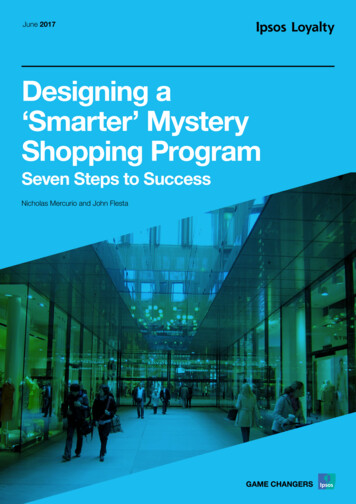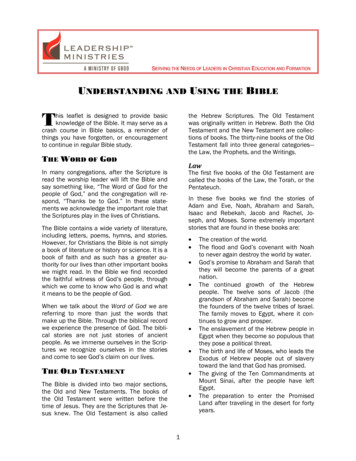
Transcription
June 2017Designinga ‘Smarter’Mystery Shopping ProgramSeven Steps to SuccessNicholas Mercurio and John FlestaDesigning a‘Smarter’ MysteryShopping ProgramSeven Steps to SuccessNicholas Mercurio and John Flestai
Designing a ‘Smarter’Mystery Shopping ProgramSeven Steps to SuccessNicholas Mercurio and John FlestaCustomer experiencehas always mattered.However, the stakes have never been higher than theyare today. In the current age of customer-centricity,consistently delivering a positive customer experiencehas never been more critical—or challenging. Aconvergence of factors – heightened consumerexpectations, a complex multichannel retailingenvironment, increased ease of online and mobileshopping and the power that social media has givenindividual consumers—makes delivering an exceptionalcustomer experience increasingly difficult.Countless research studiesshow that brands which putthe customer first and deliver asuperior experience relative totheir competition, achieve greatercustomer loyalty, higher profits andbetter returns for shareholders.Mystery shopping exists to alleviate these issues andconcerns for organizations.1
Designing a ‘Smarter’Mystery Shopping ProgramSeven Steps to SuccessNicholas Mercurio and John FlestaWhat is MysteryShopping?Mystery shopping is an observational researchmethodology that ensures brands consistently deliver onthe promises they make to customers. It leverages trained“shoppers” to go through product or service interactionsacross your enterprise and report back with a detailedand objective account of their experience. Mysteryshopping helps companies understand what their averagecustomer is experiencing, what staff behaviors should beacknowledged or rewarded, and what parts of the sales orcustomer service journey can be improved.The results are aggregated and used to identify andremedy systemic breakdowns of the desired and intendedcustomer experience. When used effectively, mysteryshopping research can be a powerful performancemanagement tool that creates awareness aroundimportant standards/initiatives and drives organizationalbehavior change—all in the spirit ofbetter serving the customer.“When used effectively,mystery shoppingresearch can be apowerful performancemanagement tool thatcreates awarenessaround importantstandards/initiatives anddrives organizationalbehavior change.”However, in our experience of designing and implementingenterprise-wide mystery shopping programs, we oftenfind that organizations are misusing the methodology. Thisresults in a program that does not deliver tangible value tothe business or meet the needs of program stakeholders.So, while it’s important to understand what mysteryshopping “is” and how it can benefit your organisation,it is also important to understand what mysteryshopping is not: It is not a way to “spy” on employees to catch themin the act of doing wrong. It is not a replacement for voice of the customermeasurement or other forms of direct customerfeedback. (Nor is Voice of the Customer(VOC) areplacement for mystery shopping). Mystery shopping is not limited to measuring complianceto brand standards in brick and mortar locations only.Today, a mystery shopping programcan be deployed across any customer channel: in-store,telephone (retail location or contact center),and across online and mobile touchpoints (website, inapp, email, etc.).2
Designing a ‘Smarter’Mystery Shopping ProgramSeven Steps to SuccessNicholas Mercurio and John FlestaMaking MysteryShopping Smarter,by DesignSTEP 1Start with StrategyLike many research programs, the absence of clearmystery shopping program objectives that look tosolve a specific business question often result in adiluted program that does not deliver clear value. Werecommend referencing your own organizationalstrategy for clear direction on your customer-facinginitiatives and how you would like to leverage mysteryshopping as a tool to enhance the customer experience.From there, you define clear objectives that align with thisstrategy and ensure that these objectives are addressedby the mystery shopping program.Beyond these methodological considerations, when wediagnose what has gone wrong with many organizations’existing mystery shopping programs, we regularly find theissues are rooted in poor program design. In addition todeploying one or more of the tactics outlined above, wealso find that organizations routinely: Ask the wrong questions, too many questions, orquestions that are not important to their customers. Experience quality issues originating from shoppersbeing recognized, which result in mystery shop inquiriesthat are time-consuming and divert the focus awayfrom making organizational improvements.Here are a few thought starters when looking forinspiration on designing your enterprise’s mysteryshopping strategy: Measuring adherence to specific brand standards orbrand promises made to your customers. Don’t derive real impact or tangible business valuefrom their programs—often because they focus on thewrong metrics or don’t properly analyze results anddisseminate program findings. Mystery shopping your competition to betterunderstand best practices and reasons for customerchurn/defection.At Ipsos, we’ve been looking at what needs to be inplace to deliver better design, better executionand better impact across our mystery shoppingprograms. Regardless of your organization’s experiencewith mystery shopping, we have developed specificsteps and a proven blueprint that should be followed tobuild a successful program and increase its return oninvestment. These are seven simple steps that you cantake to make your mystery shopping program smarter, bydesign: After a new product launch, measuring trainingeffectiveness and/or point of sale signage compliance.3
Designing a ‘Smarter’Mystery Shopping ProgramSeven Steps to SuccessNicholas Mercurio and John Flesta“While it might beimportant to you thatyour employees alwayswear a nametag, thismay or may not beimportant to yourcustomers. It mightbe more importantthat associates arefriendly, helpful andknowledgeable.Furthermore, a cleanrestroom or short waittime during checkoutmight be moreimportant to them thanwhether or not theassociate attempted toupsell them to a moreexpensive product.”STEP 2Design with YourCustomer in MindOnce you have developed your strategy, the next stepto implementing a smarter mystery shop program isto design with your customer in mind. One commonmistake made by organizations is developing a mysteryshopping program that is based on what is important tothem, not their customer.For example, while it might be important to you thatyour employees always wear a nametag, this may ormay not be important to your customers. It might bemore important that associates are friendly, helpful andknowledgeable. Furthermore, a clean restroom or shortwait time during checkout might be more important tothem than whether or not the associate attempted toupsell them to a more expensive product.There are various techniques we use to ensure customerfeedback is properly embedded in your mystery shoppingprograms. This includes using customer journey maps,conducting driver analysis with your customer satisfactiondata, and leveraging focus groups and pilots to informthe design of your program. Give thought to key“moments of truth” where you can either create painor delight from the customer’s point of view. What arethe customer’s expectations of you regarding thosemoments? Of your competition? What language does thecustomer use to talk about those moments?It can also go well beyond these primary researchmethods, such as linking sales data to channels orindividual locations and/or employee data. The programmay be tweaked over time as well to account for updatedtraining techniques and promotional activities.But don’t skip this important step. When organizationsfail to view their program through the customer’s eyes,it often results in adverse behaviors such as “scorechasing” vs. driving outcomes such as reducingcustomer churn, improving satisfaction/likelihood torecommend or driving new customer acquisition andretention.4
Designing a ‘Smarter’Mystery Shopping ProgramSeven Steps to SuccessNicholas Mercurio and John FlestaSTEP 3STEP 4Define Shopper andShop RequirementsDesign a SoundSurvey InstrumentThe next best practice is to define the shopper andshop requirements for the program. We often see thatcompanies are not deliberate or strategic in this step,and it often leads to biased program results, unnecessarycosts, or ill-informed insights.Once you have an outline of what the shop and shopperrequirements are, the next step is to design a soundsurvey instrument. This is the survey the mysteryshopper will fill out after the interaction with your brand.The survey itself will capture what you are lookingto measure and should be built in an organized andsystematic manner. In our experience, poor survey designis the single biggest factor contributing to poor programdesign and quality issues.Defining the shopper requirements starts withidentifying your target customer profiles (ideallythrough customer segmentation data). You will want tothink of both demographic and psychographic profilesof your customer base. Knowing that there will likely bemultiple segments, you must determine which will beserved by your mystery shopping program. You maydecide to look at a nationally representative sample,or you may decide that there is a need to focus on aspecific or underserved segment. This will then lead tothe specific “personas” that shoppers will either need tofit or the scenarios they will need to role play (which weelaborate upon in Step 5). First, the survey must be kept largely objective. Avoidsubjective, perception-based Likert-scale questionswithin the survey and instead focus on discrete, binaryquestions. To avoid issues with shopper recall, the survey shouldbe as short as possible (less than 30 questions is ideal)and always tied to the objectives you developed at theoutset of the program. Finally, design the survey scoring or weightingscheme, by assigning points to each question that areproportional and based on question importance.After defining who the shopper will be, you must decidethe “rules” or requirements for the mystery shop itself.You will need to think about specifics such as the storesyou would like shoppers to visit (or contact centers you’dlike them to place calls to), how many times you want tovisit that store, the daypart or day of week to conductshops, how much time the shopper will need to spend inthe store/on the phone, whether they will need to make apurchase, etc.5
Designing a ‘Smarter’Mystery Shopping ProgramSeven Steps to SuccessNicholas Mercurio and John FlestaSTEP 5STEP 6Create RealisticShopper Scenariosand Thorough BriefingMaterialsFormulate a Smart andStrategic Sampling PlanThe sixth step you must take to design your mystery shopprogram is to formulate a smart and strategic samplingplan. There is no clear-cut answer to how many shopsyou should conduct, the number of shoppers or scenariosyou should deploy, and/or how frequently you should bevisiting a specific location.You should also be designing the mystery shopscenarios and briefing materials in parallel with the surveyinstrument. The mystery shop scenario differs fromthe survey itself as it is the script, situation or “persona”that you would like the mystery shopper to role play whilein the store (or on the phone, online, etc. depending onyour program). Briefing materials are leveraged to trainthe shoppers on how the interaction should play out.This is critical to ensuring consistency, quality, and overallsuccess in your program, no matter what size or scaleyou are looking to deploy.However, the “every location, every month” method ofmystery shopping is obsolete and will often result inspending more on mystery shopping than is realisticallyrequired.However, if you tie your sampling plan back to yourstrategy and objectives, you will be in a better positionto answer these questions. Whenever available andapplicable, there are several areas worth considering: Leverage sales data to potentially shop at the highest(or lowest) grossing locations as they may warrant moreregular measurement.For years, shopper briefing materials have beendeployed via written instructions that outline each stepof the process. While this can be effective, designing asmarter program means leveraging technology acrosseach phase of the program—including shopper briefing.Deploying video briefing materials via short, engagingmultimedia clips is an effective way to illustrate what youwant to accomplish during the mystery shops, while alsodemonstrating to the shopper where they may encounterpivot points throughout the shop scenario. Leverage customer experience data to potentially visitlower-performing locations more frequently. If specific geographies, regions or districts within yourorganization receive a disproportionate number ofcustomer complaints, it may make sense to mysteryshop them more often.We often help our customer “get more, for less” bydeploying many of the tactics outlined above to developa “smart sampling” approach. This involves combiningprogram objectives, business or customer data (suchas sales or customer satisfaction data) with statisticalmethods to determine the volume and frequency ofmystery shops. Over time, your sample plan can (andshould) be adjusted to meet the changing needs of yourorganization and your customer. This will lead to strongereconomies of scale and will optimize the program spendfor your organization.You should also consider developing an online shoppercertification to ensure they understand and haveretained the materials. This allows for an added level ofconfidence and credibility throughout the organization onwho is conducting the mystery shops and the results thatcome back.Another best-practice includes conducting calibrationshops (several test shops conducted by programstakeholders) to ensure your intended mystery shopdesign is feasible and capturing the type of informationyou intend.6
Designing a ‘Smarter’Mystery Shopping ProgramSeven Steps to SuccessNicholas Mercurio and John FlestaDesigning a smart sampling plan also involvesdetermining the right channels to shop (brick andmortar, contact center, online and mobile) as well asdeveloping the right mix of shop type and complexity.We have helped countless customers optimize theirbudget by including MicroShops (short, tactical,crowdsourced mystery shops) into their sample plan thatcan often be executed faster and cheaper than traditionalmystery shops.STEP 7Design YourAnalytical PlanThe last step in designing an optimal mystery shopprogram is to design your analytical plan. Too often,companies rush to field data without proper thought toinsight creation, who will access results of the program,where and how. This often leads to a predicament whereresults aren’t actionable, or don’t return the answers youneed to address your specific business question.First, you need to develop a full analytical plan beforelaunching and executing the mystery shops themselves.An analytical plan is simply an outline of the reportingdeliverable you expect to receive upon completion of thestudy. It outlines the questions you want answered, yourhypotheses to these questions, and a topic-by-topicassessment of the analytic approaches you will take toget there. A proper analytical plan can help yourteam validate or refute the learnings at the end ofa study. Be sure to identify the sub-groups of informationthat you want to understand in the analysis – that couldbe across geographies, sales channels, and anything elsethat is warranted.“The ‘every location,every month’ methodof mystery shopping isobsolete and will oftenresult in spending moreon mystery shoppingthan is realisticallyrequired.”SummaryA smarter designed and optimized mystery shoppingprogram will increase the long-term impact on yourenterprise. By measuring the proper customer journeyand the right channel(s), you can drive improvementsthroughout the business. Leveraging the tips above willhelp improve the design and operational execution ofyour mystery shopping program, but will also drive moreimpactful results and help create true behavior changeacross your organization.7
Designing a ‘Smarter’Mystery Shopping ProgramSeven Steps to SuccessNicholas Mercurio and John FlestaNicholas Mercurio is Senior Vice President of MysteryShopping for Ipsos Loyalty in the USJohn Flesta is Vice President of Customer Experienceat Ipsos Loyalty in the USIpsos Loyalty is the global leader in customer experience, satisfaction,and loyalty research with over 1,000 dedicated professionals located inover 40 countries around the world. Our creative solutions build strongrelationships which lead to better results for our clients. This has madeus the trusted advisor to the world’s leading businesses on all mattersrelating to measuring, modeling, and managing customer andemployee relationships.Ipsos Mystery Shopping is one of the largest mystery shopping agenciesin the world. We complete over a million walk-in, phone, and web shopsevery year across all industry segments and organization sizes.Our clients benefit from our highly experienced team, global reach,local presence, research expertise, and innovative approach to designingand managing mystery shop programs. Ipsos belongs to ESOMAR andMSPA and adheres to their codes of conduct in conducting mystery shopping.The Ipsos Views whitepapers are produced by theIpsos Knowledge Centre.www.ipsos.com@ IpsosIKC@ipsos.com Game Changers is the Ipsos signature.At Ipsos we are passionately curious about people,markets, brands and society. We make our changingworld easier and faster to navigate and inspireclients to make smarter decisions. We deliver withsecurity, simplicity, speed and substance. We areGame Changers.8
Mystery shopping exists to alleviate these issues and concerns for organizations. 2 Designing a ‘Smarter’ Mystery Shopping Program Seven Steps to Success . methods, such as linking sales data to channels










